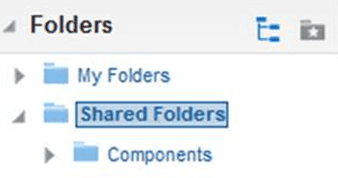
Topics:
· Post Deployment Configuration Checklist
· Managing OBIEE or OAS Activities
· Configuring Reconciliation Framework Analytics v8.1.1.0.0 Dashboards and Reports
· Deploying Reconciliation Framework Pack Analytics
· Starting Node Manager and WebLogic Servers
· Logging in as System Administrator
· Mapping Application User(s) to User Group
Sl. No. |
Post-deployment configurations |
|---|---|
1 |
Installing OBIEE or OAS Server |
2 |
Installing OBIEE or OAS Windows Administration Client |
3 |
Configuring Reconciliation Framework Analytics v8.1.1.0.0 Dashboards and Reports |
4 |
Deploying Reconciliation Framework Pack Analytics |
5 |
Starting Node Manager and WebLogic Servers |
6 |
Logging in as System Administrator |
7 |
Create Application Users. |
8 |
Map Application User(s) to User Groups. |
Topics:
· Installing OBIEE or OAS Server
· Installing OBIEE or OAS Windows Administration Client
To install the Oracle Business Intelligence Enterprise Edition (OBIEE) server, see the Oracle Fusion Middleware Installation Guide for Oracle Business Intelligence12c Release 1 (12.2.1.4.0).
If installing OAS Server, see Installing and Configuring Oracle Analytics Server.
After installation, get the Enterprise Manager URL, username, password, and OBIEE installed directory from the System Administrator.
To install the OBIEE repository administration client for a Windows machine, see the Oracle Fusion Middleware Installation Guide for Oracle Business Intelligence12c Release 1 (12.2.1.4.0).
To configure Reconciliation Framework Analytics v8.1.1.0.0 Dashboards and Reports after Oracle Business Intelligence (OBIEE) or Oracle Analytics Server (OAS) Server installation, follow steps provided in the following sections:
Prerequisites
1. Make sure OBIEE (Version 12.2.1.4) or OAS (Version 5.5.0) is installed and is available.
2. If the OBIEE or OAS is installed in a non-Windows environment, make sure that a standalone OBIEE or OAS client is installed in a Windows environment.
Topics:
· Modify Repository Connection Pool Settings
· Deploy RPD file for OBIEE or OAS
· Deploy Web Catalog for OBIEE or OAS
To modify Repository Connection Pool Settings, follow these steps:
1. Copy the Repository file from the $FIC_HOME/GLBI and place it in a local folder on the Windows system.
2. Open the BI Administration tool in the Windows client machine.
3. Click Start and then select Programs then Oracle Business Intelligence Enterprise Edition Plus Client and then Administration.
4. Click File and then Open and then Offline.
5. Locate and open the file named OFS_GL_8.1.rpd.
6. Provide Repository Password. See the MOS Doc ID: 2691681.1 for the default password.
7. For connection pool settings, see the configure the Connection Pool of the Repository section.
To deploy the RPD file, follow these steps:
1. EM does not have an option for deployment of RPD. It uploads a repository to a specific service instance. You must use the WebLogic scripting command uploadrpd to upload a repository to Oracle BI Server.
2. Execute the utility through a launcher script, datamodel.sh on UNIX, and data-model-cmd.cmd on Windows. Ensure you place the RPD file anywhere in the server where OBIEE is installed before starting the upload command.
3. You can find the launcher script at the following location:
<Oracle_Home>/user_projects/domains/bi/bitools/bin
4. Enter the following commands in shell to upload the RPD:
uploadrpd -I <RPDname> [-W <RPDpwd>] -SI <service_instance> -U <cred_username> [-P <cred_password>] [-S <hostname>] [-N <port_number>] [-SSL] [-H]
For example: ./datamodel.sh uploadrpd -I </PathofRPDfile/RepositoryName.rpd> -SI ssi -U weblogic -P password
1. After logging on to the OBIEE or OAS URL, navigate to the Catalog tab and click Shared Folders.

2. Click Unarchive on the Tasks pane.
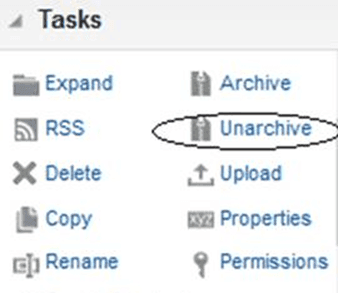
3. Browse to the path of the catalog file placed in your local machine and click OK.
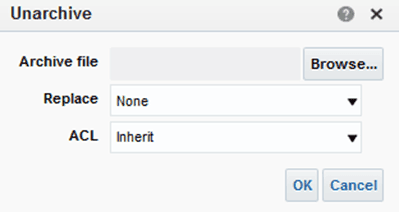
4. Start the Analytics services
You can start the Oracle Business Intelligence system components by any of the following methods:
a. For OBIEE or OAS
i. Navigate to ORACLE_HOME\user_projects\domains\bi\bitools\bin.
ii. Run the Start.sh command to start services.
5. Testing the Analytics reports
a. Log in to http:// <host server name or IP>:<Port No default is 9502>/analytics/saw.dll?Dashboard using your Administrator credentials created during platform install.
b. Check for the availability of reports.
c. In case of any problem, check for the log files present in the respective diagnostic folders of the analytics server, that is, <OBIEE or OAS Install Folder>/servers/bi_server1/logs.
To deploy Analytic Reports, perform the following steps:
1. Copy OFS_GL_8.1.rpd from $FIC_HOME/GLBI of Web layer to the Windows machine where the OBIEE or OAS Windows administration client is installed.
To change the default password for the repository, perform the following steps:
1. Open the repository using OBIEE or OAS Windows administration client.
2. Select OFS_GL_8.1.rpd file. Click Open.
The OBIEE or OAS Windows Administration Client to enter Repository Default Password is displayed.
3. See the MOS Doc ID: 2691681.1 for the default password.
4. Click the File menu and select Change Password.
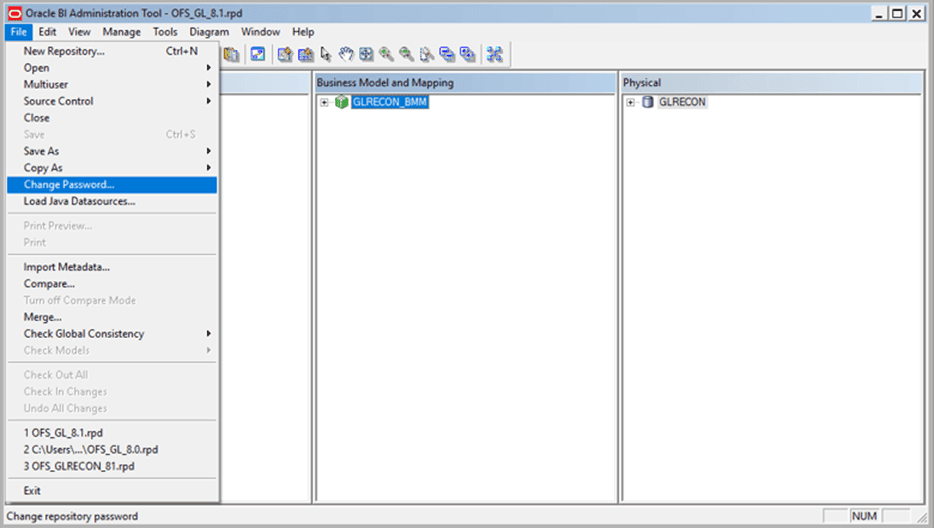
5. Enter the new password. Click OK.
To configure the Connection Pool of the repository, perform the following steps:
1. In the Physical section, expand GL directory.
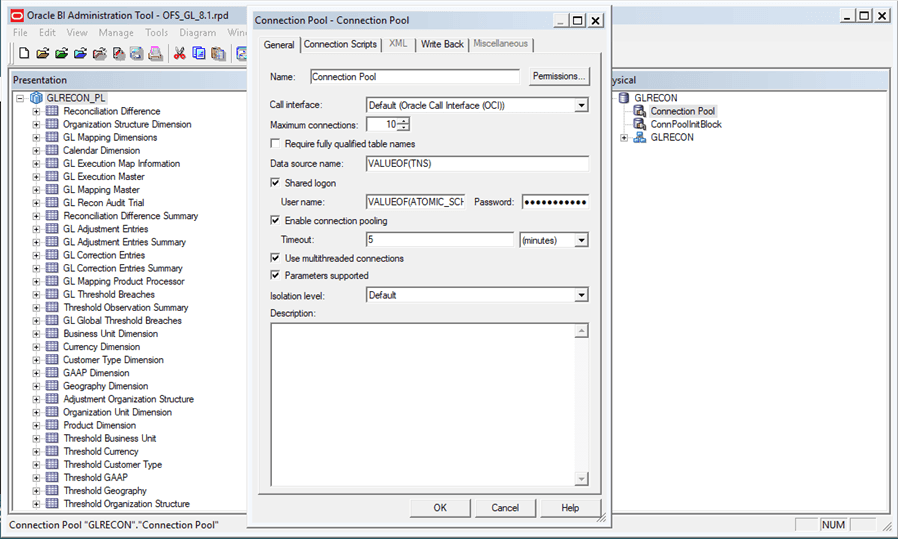
2. Double-click Connection Pool to open the Connection Pool Properties window.
3. Enter the atomic schema user password in the Password text box.
4. Click OK.
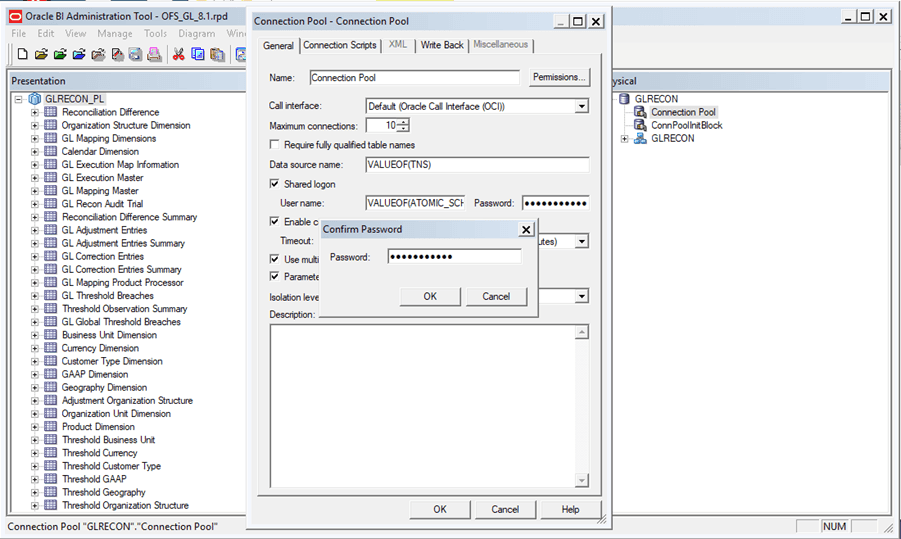
5. Double-click Initialization Blocks to open the Connection Pool window.
6. Enter the atomic schema password in the Password text box.
7. Click OK.

8. Click the File menu and then click Save.
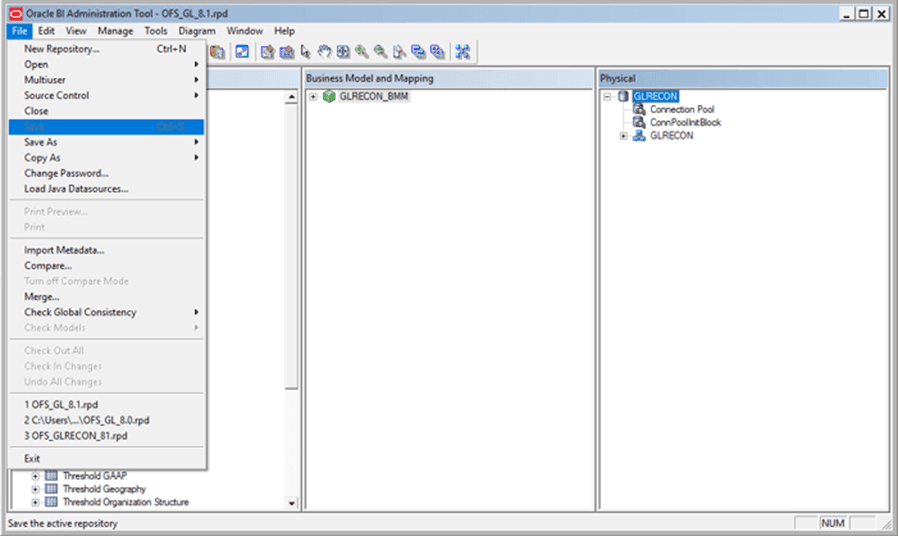
9. Click Yes to acknowledge the message: Do you want to check global consistency?
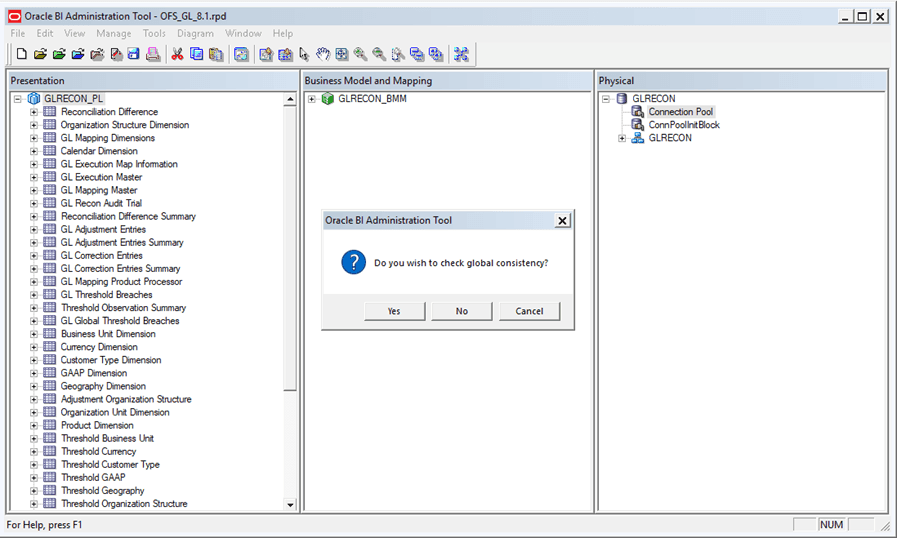
10. Click OK to acknowledge the confirmation message: Consistency check didn't find any errors, warning or best practices violations.
NOTE:
Warnings on consistency checks can be ignored.
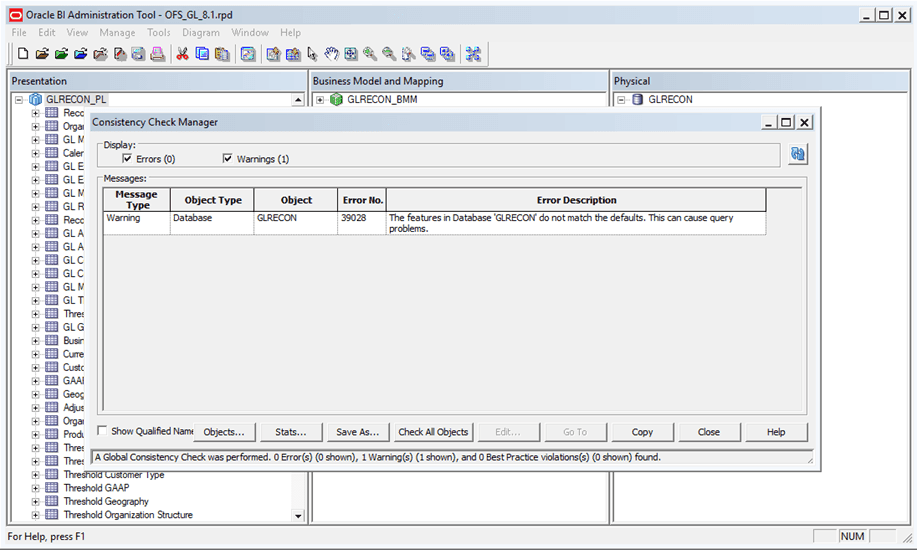
The RPD and catalog are deployed and the application is ready to view the reports.
For details, see Oracle Business Intelligence Configuration Guide.
This section includes information about the roles and privileges of the System Administrator.
Topics:
There are two types of Administrators as defined by the OFSAA Infrastructure: a User Administrator and a System Administrator.
· System Administration refers to a process of managing, configuring, and maintaining confidential data in a multi-user computing environment. A System Administrator creates functions, roles, and mapping functions to specific roles. They also maintain segment information, holiday list, and restricted passwords to ensure security within the application. In addition, the System Administrator also performs the following actions :
§ Function Maintenance
§ Role Maintenance
§ Function-Role Mapping
· User Administration is one of the core functions of Security Management which involves administrators to create user definitions, user groups, maintain profiles, authorize users and user groups, and map users to groups, domains, and roles. A User Administrator controls the user privileges in accessing the application and is based on business requirements to provide access to view, create, edit, or delete confidential data.
A User Administrator grants permissions based on user roles and requirements.
The respective roles must be mapped to an administrative user SYSADMN.
For details, see the System Administrator section in the Oracle Financial Services Analytical Applications Infrastructure User Guide.
For details, see the System Administrator section in the Oracle Financial Services Analytical Applications Infrastructure User Guide.
For details, see the System Administrator section in the Oracle Financial Services Analytical Applications Infrastructure User Guide.
For details, see the User Group Role Map section in Oracle Financial Services Analytical Applications Infrastructure User Guide.
To create application users in the OFSAA setup, see the User Administrator section in the Oracle Financial Services Analytical Applications Infrastructure User Guide.
For details, see the User Administrator section in the Oracle Financial Services Analytical Applications Infrastructure User Guide.
Beginning with the OFSAA 8.1.1.0.0 release, with the installation of the OFSAA Reconciliation Framework application pack, preconfigured Application user groups are seeded. These user groups are unique to every OFSAA Application Pack and have application roles pre-configured.
For more information on seeded User Groups, see OFSAA Reconciliation Framework application pack User Group Names.
Map the application user (s) to the respective Application User Group (s) and subsequently authorize the entitlements by logging in as SYSAUTH (System Authorizer) user.
For details, see the Mapping/Unmapping Users section in the Oracle Financial Services Analytical Applications Infrastructure User Guide.
The User UserGroup Map facilitates you to map user(s) to a specific user group which in turn is mapped to a specific Information Domain and role. Every UserGroup mapped to the infodom must be authorized. Else, it cannot be mapped to users.
The User UserGroup Map screen displays details such as User ID, Name, and the corresponding Mapped Groups. You can view and modify the existing mappings within the User UserGroup Maintenance screen.
With the installation of the OFSAA Reconciliation Framework Pack, pre-configured Application user groups are seeded. These user groups are unique to every OFSAA Application Pack and have application roles pre-configured.
You can access the User UserGroup Map by expanding the User Administrator section within the tree structure of the LHS menu.
After the user is created for Reconciliation Framework, map them to the following user groups:
1. Recon Administrator
2. Recon Framework Analyst
3. Recon Framework Authorizer
4. Adjustment Super Group
Part II
Topics: